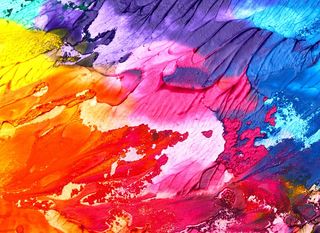Bipolar Disorder
Are Creative People Crazier?
Yes, being "a little bit" bipolar or schizophrenic is linked to creativity.
Posted April 15, 2019 Reviewed by Davia Sills

There's an old idea that madness and genius go together. We like to link art and danger, imagining that artists, like Christ figures, suffer for our sake, enduring poverty and terrors in order to bring us beauty and healing.
The truth is that mentally ill people are not notably creative. However, the latest science with large data sets demonstrates a slight tilt towards mental illness among creative people well short of the myth. It may help to be "a little bit" manic or psychotic, but not enough that you're ill.
When researchers in Sweden conducted studies on the general population over a period of 40 years, they found that bipolar disorder—but not schizophrenia, depression, anxiety disorders, alcohol abuse, drug abuse, ASD, ADHD, anorexia nervosa, or completed suicide—was over-represented among people in artistic and scientific occupations.
The healthy close relatives of people with bipolar disorder, schizophrenia, and anorexia nervosa were also somewhat over-represented. "The likelihood of being an author doubles if you are a relative of someone with bipolar disease or schizophrenia," notes co-author Simon Kayaga, a psychiatrist and researcher at the Karolinska Institute in Stockholm.
Siblings of people with autism were also over-represented. But people with depression and their relatives were not. Other research found that among Icelanders, gene markers for schizophrenia and bipolar disorder risk were more common in creative occupations.
The evidence with relatives suggests a pool of people who may have mild symptoms that wouldn't warrant a diagnosis. "There is a continuum for every mental illness. You can have a little ADHD, a little depression, or be a little bipolar," explains Selcuk Acar, from the International Center for Studies of Creativity in Buffalo. "You may not need medication, but may need to learn coping strategies."
Imagine being "in the zone" or "flow"—so excited by your project, you lose track of time, forget to check your email and texts, and miss meals and sleep. You may be astonished by your productivity and inventiveness. You might say you feel "manic," but happily so.
If you were to progress to the mania of bipolar disease, you might become wildly exuberant and speak in a rapid cascade of ideas—but also completely stop sleeping, impulsively overspend, and hallucinate or develop delusions. Where you are on the spectrum matters, and if you're too far along, the deficits of the disease could well overpower the creative flare.
Mania will ultimately interfere with your work. "There's an in-between when I feel the most productive and creative," says Jason Bee, a screenwriter and mental health advocate who created a movie with a bipolar hero, Donovan. "When I get too manic, there's no focus."
People with bipolar disease who cope well stick to sleeping schedules and other routines to avoid triggering symptoms. If you're a creative person with a tendency to mood swings, you may also need to even yourself out to stay productive.
A Little Schizophrenic
Similarly, you can live in the hallway of schizophrenia without entering that dark room. In the mid-1990s, psychologists developed a questionnaire to measure schizotypy or schizophrenia-proneness. Schizophrenia patients score more highly than controls on these tests, and so do bipolar patients. As it happens, the genes for the two illnesses overlap, and both may run in the family.
Being what you might call "a little schizotypy" isn't rare. "Psychotic and psychotic-like thoughts" are fairly common in the general population, notes a 2015 article in Schizophrenia Bulletin titled "Schizotypy—Do Not Worry, It Is Not All Worrisome." It points to evidence that most people who have those psychotic-like thoughts never experience psychiatric illness.
The Old and New Testament, of course, are full of people hearing divine voices. And some modern prophets and leaders make these claims too. Martin Luther King, Jr., for example, reported hearing "the voice of Jesus saying still to fight on."
Charles Dickens was described by critics in his time as hearing voices. He may also have hallucinated visions. The author wrote to his friend John Forster: "When I sit down to my book, some beneficent power shows it all to me and tempts me to be interested, and I don't invent it—really do not—but see it, and write it down."
The schizotypy test measures four dimensions. One is unusual experiences, which include not just hallucinations and delusions but also magical thinking and "overinclusive thinking," when you are unable to stay within the socially-defined topic. Mark Runco, the editor of the Creativity Research Journal, uses a test for creativity in which you get points if you believe in ESP. The key is that "you are embracing socially unacceptable ideas," explains Acar.
A second dimension is disorganized thinking. A third is violent or reckless behavior or violent thoughts. The fourth is social withdrawal combined with a lack of pleasure. Poets and visual artists score highly on unusual experiences and violent or reckless behavior and thinking—two aspects of non-conformity—but not on the other two, which are more characteristic of the clinical population.
Creativity may be the upside of schizophrenia genes. Some research even finds that people with schizotypy attract more sexual partners. That's hard to understand unless it is a marker for creativity—clearly more useful for survival than schizophrenia, a debilitating illness that drastically cuts your chances of raising children. The mystery is why it has persisted over centuries, but bad genes may survive when linked to adaptive traits.
Depression Calling
The survival of depression is another puzzle since it makes people slow to a crawl and even kill themselves. Its link to creativity emerges most clearly with one group—creative writers.
Among all the arts, creative writing also stands out as more associated with mental illness.
In the Swedish research, book authors, unlike the overall group of creatives, were more likely to suffer from depression as well as schizophrenia, bipolar disorder, anxiety, and substance abuse. They were also more likely to die by suicide—perhaps haunted by the deaths of Virginia Woolf, Ernest Hemingway, Sylvia Plath, and many others. John Cheever, the great short story writer afflicted with depression and alcoholism, was convinced that writing depressed him.
In the end, most creative achievers are not ill. What they share is motivation. Harvard psychiatrist Albert Rothenberg and his team spent 25 years interviewing living artists and scientists who had won prestigious awards, tracking their progress on various projects. He concluded that "Only one characteristic of personality and orientation to life and work is absolutely, across the board, present in all creative people: motivation. They want specifically to create and be creative, [which requires] direct, intense, and intentional effort."
A longer version of this article appears on newsstands in the publication Creativity from Centennial.




